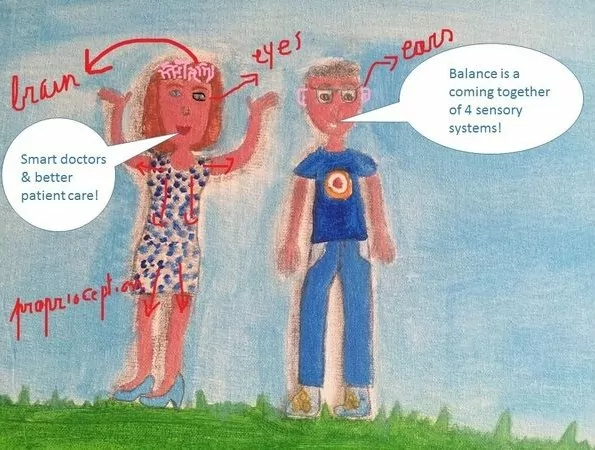
A group of vestibular patients has created a petition to urge the World Health Organization to consider better awareness of vestibular disorders among primary care physicians and specialists, and multi-disciplinary teams to diagnose and treat vestibular patients.
Goal
We aim to give vestibular / neurovestibular patients a better chance for swift and accurate diagnosis, a cure or appropriate treatment. We ask for a worldwide agreement on education of medical students, further training for existing specialists and the establishment of medical guidelines regarding vestibular conditions / disorders.
The problem/situation today
“More than 1 in 20 US children between the ages of 3 and 17 have dizziness and balance problems.” (Sciencedaily)
“A variety of balance disorders affects up to 30–40% of the population before they reach the age of 60. About a quarter of those affected will have to take time off work, with a large socioeconomic cost when untreated. However, because of complexity of the balance control mechanisms, patients with balance disorders may have to see several doctors / consultants at primary and secondary care level before a correct diagnosis is made. Therefore vestibular / neurovestibular patients may remain without a correct diagnosis and without appropriate care for very long periods of time.” (EMBalance)
“The presence of dizziness in the elderly is a strong predictor of falls, which is the leading cause of accidental death in people older than 65 years.” (Frontiers in Neurology)
Doctors report that they are often poorly trained in vestibular and neuro-vestibular conditions. “Misdiagnosis rates in the Emergency Department for peripheral vestibular disorders are estimated in the range of 74 to 81%.” (Neurologic Clinics)
Additionally, because there is a lack of understanding of these disorders, GPs may prescribe vestibular suppresent medications as a ‘treat all’ which can cause further damage as these are only suitable for certain conditions and can be harmful for others.
Likewise they may want to treat using the Epley manouver on the basis of symptom descriptions rather than appropriate testing. Whilst this can help with BPPV it can be harmful for people with other vestibular / neurovestibular conditions. So the guidance here needs to be for GPs not to treat the symptoms until an accurate diagnosis has been made.
Likewise they prescribe Betahistine; it works for Ménière’s, but can keep a patient with another disorder ill for even a longer period.
How to make the changes doctors and patients need
Misdiagnosis / mistreatment being a worldwide problem, we endeavour to empower doctors to help more people regain their lives.
We ask:
1) These basics:
- For a greater understanding amongst the entire medical profession of the following principle: that our balance is not only a matter of our vestibular system (and thus coming under the specialism of ENT) but rather a coming together of 4 sensory systems: the vestibular system, the visual system, the proproceptive system and central brain processing systems (cerebellum etc).
- That vestibular disorders should not be the expertise of ENT only. Doctors working in the field of ENT, neurology, ophthalmology / eye doctors, audiology and physiotherapy (physical therapy) – and, crucially, geriatrics for the elderly – should work together in multi disciplinary teams to give their patients a better chance for a cure or appropriate treatment. We also ask them to share the latest knowledge and new research outcomes across disciplines and with patients.
- That balance and vestibular conditions / disorders become a mandatory, full and substanciated part of all general medical studies due to the percentage of the population who present with these conditions.
- That retraining in General Practice should include balance / vestibular disorders training as a matter of priority. As a result of this, all GPs should know how to make appropriate referrals for testing and treatment. We want them to be aware of these basics: a peripheral vestibular disorder is a dysfunction of the balance organs of the inner ear. A central vestibular disorder is a dysfunction of one or more parts of the central nervous system that processes balance and spatial information. And each disorder needs a different approach – Vestibular Neuritis, Labyrinthitis, Benign Paroxysmal Position Vertigo, Ménière’s Disease, Vestibular Migraine, Vestibular Paroxismia, Superior Semicircular Canal Dehiscence syndrome, Mal de debarquement syndrome, Perilymph Fistula, Autoimmune Inner Ear Disease, Persistent Positional Perceptive Dizziness or Triple PD and Bilateral Vestibulopathy, Childhood Dizziness… and even more to be discovered by research…
2) For diagnosing:
- The ‘SO STONED’ diagnostic mneumonic to be adopted worldwide to guide the clinician to an accurate diagnosis. Key factors that allow a first approximation of diagnosis identification are based on the time profile, symptom profile, and trigger profile of the disorder. “SO STONED” comprises eight different dimensions that characterize the vertigo-related complaints of the patient and guide the clinician in his or her decision scheme.
- That all doctors pay attention to these life threathening diseases:
- A brain tumor to be ruled out
- The BE FAST method to be used to rule out stroke when a clinician sees a dizzy patient (World Stroke Campaign): Balance – Eyes – Face – Arms – Speech – Time – Call 911 for immediate medical attention.
- That all doctors remember to ‘Think Zebra’. Within the category of vestibular / neurovestibular conditions there are two rare disorders: SCCD (peripheral) and MdDS (central). But there are also many other rare conditions which have symptoms that overlap with more common balance conditons, including IIH and the less common forms of ataxia.
3) Certification: That professionals who adopt this approach and develop this expertise be granted appropriate certification / accreditation and listings in relevant registries.
4) Medicine to benefit from empowered patients: That patients are involved in this process as much as possible, for example via health conferences that have patients on stage and in the program. Patients also have a valuable role to play in providing training and with the design of research.
Outcomes
As well as revolutionising health care for patients with primary vestibular / neurovestibular conditions this approach will add to the cadre of doctors who are able to support patients with a wide variety of conditions that can have an impact on balance, including Vision Disorders, Parkinson’s, Multiple Sclerosis, Cerebral Palsy, Hyperventilation, Neurofibromatosis etc etc.
About us
My name is Tania Stadsbader (Belgium) and I took the initiative to set up this petition. I am an ex BPPV patient enjoying a second life without vertigo. For 15 years I was misdiagnosed and mistreated so I am highly motivated to do everything I can to ensure this doesn’t happen to anyone else (but it does too many times…). I wrote a book, ‘Dizzy Me, shedding light on balance’ involving an innovative partnership between doctors and patients (coauthor prof. dr. F Wuyts). I am also a VeDA Ambassador, working with doctors and patients to raise awareness about all vestibular conditions. I started campaigning after my life-changing surgery in 2008 – via website dizzyme.eu, a Facebook page and my authors page and Twitter. Actually ‘dizziness’ plays a central role in my life for 23 years. Being 46, those 23 years represent 1/2 – and the period ‘being ill’ represents 1/3 – of my entire life! Now I launched this petition to speed up change in medicine and care.
These are my fellow campaigners:
- Verony Manders (The Netherlands) is striving for a multi-disciplinary approach for 35 years, based on the principle that our balance is a coming together of the 4 sensory systems explained in this petition. For 35 years she was misdiagnosed and mistreated and she pays a high price for this; so she is highly motivated to do everything she can to ensure this doesn’t happen to anyone else. Now she asks ENT, neurology and ophthalmology to work together. She raises awareness with her page Eerlijk over Evenwicht.
- David Morrill (USA) is a stroke survivor and works with a team of Healthcare professionals led by John Hopkins University to help facilitate the difference between acute vertigo and stroke and the propensity to be a diagnostic error in the Emergency Room setting. He is also a VeDA Ambassador. Watch him on video.
- Chris Daws (Australia) focuses on patients with MdDS, a very under- represented group of neuro-vestibular patients. Mal de Debarquement Syndrome has been with Chris since December 2012, after disembarking from a river cruise in Germany. After 2 misdiagnoses and being told to go home and and deal with it, she now leads a support group for those with MdDS in Australia. The aim of MdDS Australia is to raise awareness of this condition together with providing ongoing support and friendship. Chris is also a VeDA ambassador.
- Tamar Schwarz (USA) is blogging under the name Visible Person, Invisible Problem on ‘the invisible factor’ of vestibular and vision disorders. Vision plays a key role in the entire system of balance. She is also a VeDA Ambassador.
- Kim Striber (USA) was once a nurse, caring for patients. Today she is a patient needing expert care. Her life had been filled with outdoor adventure before she got her Central Vestibular Disorder diagnosis. She now runs a page TrekToBalance. She is also a VeDA ambassador.
- Polly Moyer (UK) campaigns for people with rare conditions and for the organisations set up to support and empower ‘zebra’ patients. She has blogged for several of these organisations and gives presentations about rare conditions to medical students. In May 2016 the BMJ – formerly the British Medical Journal – published her article ‘Healthy approaches to rare conditions’ . Polly is also the co-founder of Action for MdDS UK.
- Margaret Byrne (USA) was a Certified Occupational Therapy Assistant (COTA), working with children with Neurological, Sensory, and Developmental Issues. She was misdiagnosed for one year and now has a chronic Vestibular Disorder and blogs about living with one. She blogs under the name Sneezemedizzy and she is also a VeDA Ambassador.
- Richard Brinkman (The Netherlands) runs a page Evenwichtblog.nl sharing his search for a right diagnosis and cure. He recently got the Vestibular Paroxysmia diagnosis and hopes to finally get an appropriate treatment.
- Beth Rye (UK) is a young woman who has been suffering from an extremely rare inner-ear condition called superior semicircular canal dehiscence (SSCD) since June 2013. Beth’s symptoms started at the age of 23, as she was just completing her nursing degree. After 18 months of trying to get a diagnosis, 14 weeks in hospital and two failed operations, she was left with very few options in the UK. Her brother started the Getting Beth Better crowdfunding campaign to raise money needed for Beth to travel to Boston to be treated for her condition. Beth had surgery in July 2015 and is still receiving treatment.
- Liesbeth Duits (The Netherlands) is a very young woman suffering from an extreme vestibular condition. Her illness started in 2011, but even today no doctor has been able to find the cause nor treatment to get her better. She has a blog Hearme2 which means ‘hear me out’ and tells us about her endless search for appropriate diagnosis / treatment. “Most frustrating is that a patient is no longer a person but just a number. The struggle against rigide systems and doctors who don’t analyze my illness as a team. Not looking at me as a person. And when they don’t, I am left with no options for a treatment.”
